レポート
1. Asia-Pacific private equity: Working through a multiyear transition
After a second year of disappointing results coming off a decade of record capital inflows, it is increasingly clear that the private equity (PE) market in the Asia-Pacific region has hit a wall of reality. Amid slowing economic growth and a difficult deal environment, many PE funds have struggled to deliver on the skyrocketing expectations of the pre-2011 boom period. Investors have cut back new commitments as they wait for earlier bets to pay off.
This downtrend is scarcely what investors imagined when they flooded into hot markets such as China, India and Indonesia, eager for exposure to double-digit economic growth and expanding legions of middle-class consumers (see Figure 1.1). What’s become evident, however, is that the situation on the ground has been much more difficult than anticipated.
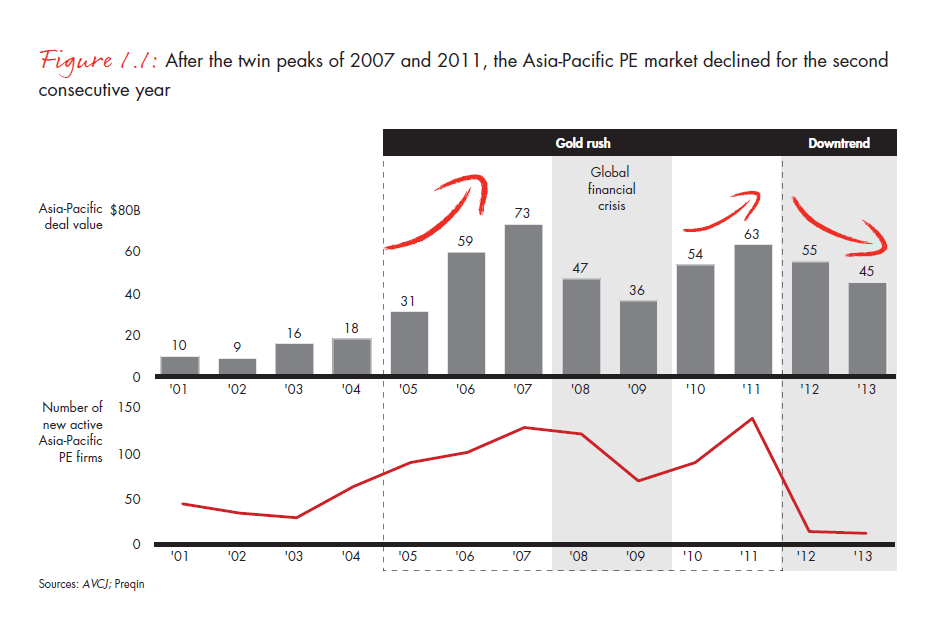
With economic growth slowing—most notably in China—and some markets hampered by currency and governance issues, many companies acquired at peak prices during the boom years have come under pressure. But because a large number of deals in Asia were structured with minority stakes, the industry has found itself with a limited ability to affect outcomes. Meanwhile, volatility in the IPO markets has made it difficult to exit even winning investments. The result is that funds have been forced to hold on to aging portfolio companies for longer than they would like, and growing piles of unspent capital have ensured that competition for any new deals is intense, keeping valuations high.
A look behind the headline numbers, however, provides ample reason for optimism. The extended downturn in the Asia-Pacific region is forcing a healthy shift in the behavior of PE firms (general partners, or GPs) and their investors (limited partners, or LPs), which is already setting the stage for a new period of more sustainable growth. Given the region’s persistent challenges, progress will not be immediate. But a burst of new activity in early 2014 has given the industry some welcome signs of momentum.
LPs continue to express confidence about Asia’s long-term growth potential. But as they wait for earlier commitments to prove out—especially in overinvested markets like China and India—they are slowing the pace of new Asia-Pacific investments to the benefit of previously dormant developed markets like North America and Western Europe. In addition, they are shifting their focus to a “newer” set of emerging markets like Sub-Saharan Africa and Latin America.
At the same time, LPs are becoming increasingly selective with their commitments in the Asia-Pacific region. A clear flight to quality is taking place, accelerating a shakeout among GPs (see Figure 1.2). Over time, that promises to reduce the market’s overcrowding and eliminate those PE firms having trouble producing results. The transition is proving slow and painful, but it will ultimately help restore growth.
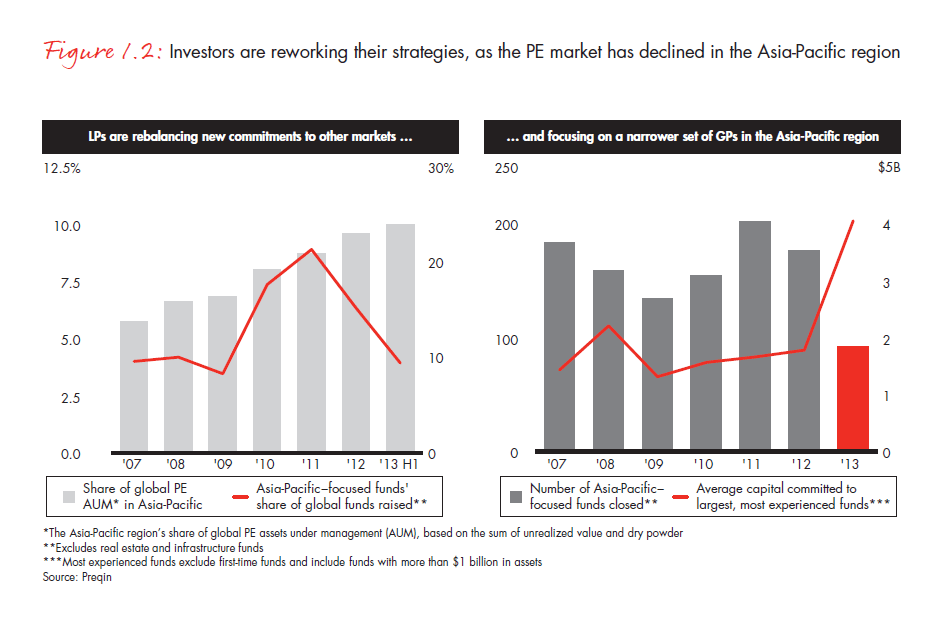
The GPs weathering this transition are progressively shifting their focus and raising their game. The best are sharpening their investment model by taking a more activist approach to deals and more closely defining where they create the most value. At their portfolio companies, they are insisting on a seat at the table so they can stay actively involved throughout the ownership period. Like their LPs, they are also extending their geographic focus as they search for potential deals. And they are diversifying their risk by opening their portfolios to a broader set of investment vehicles, such as real estate, infrastructure, hedge funds and public equity (see Figure 1.3).
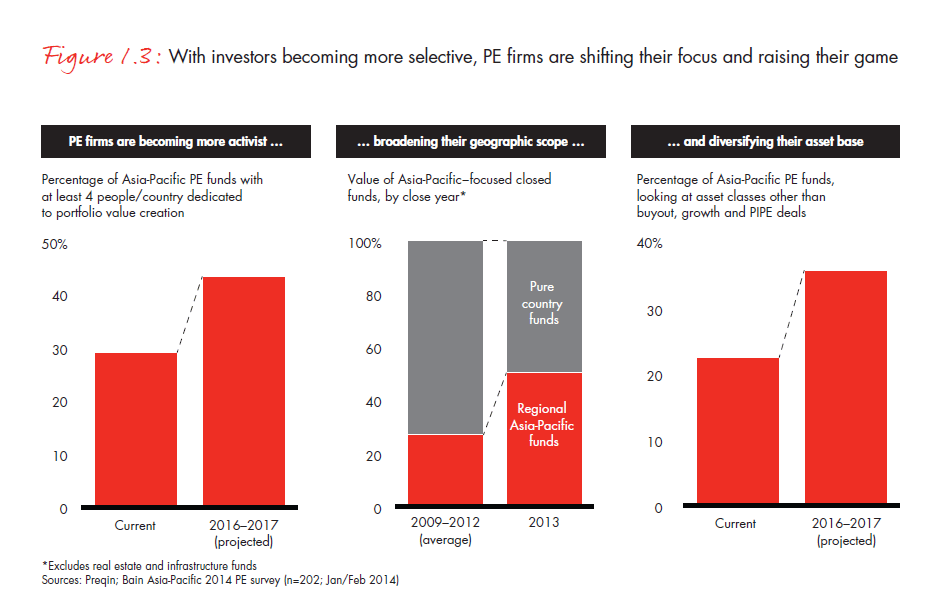
How long this essential “cleanup” phase will take is hard to predict. At the moment, the Asia-Pacific region continues to suffer from a surfeit of unexited companies bought at high valuations, and the market still includes underperforming GPs trying to spend dry powder or unwind troubled portfolios. The good news, however, is that progress is being made. Though unrealized value remains high, only a third of that total represents assets purchased near the market’s pinnacle. Newer money has increasingly flowed to the most successful PE firms.
That is priming the best players to take advantage of a still-vigorous long-term growth story in the Asia-Pacific region. Despite this period of sluggishness, the region’s diverse set of economies still outperforms the global average, powered by rapid development and modernization. Although many hurdles remain, government policy in some countries, like China and Korea, is creating an increasingly friendly environment for investment. Private equity is significantly underrepresented in the region relative to the rest of the world, and each year more local company owners get comfortable with PE’s value proposition.
In our view, these positive market dynamics will help reduce the time it takes to work past the downtrend in the Asia-Pacific region. LPs have hardly abandoned the market—their assets under management in the region are still well above where they were five years ago. But as they shift their bets to GPs that can make their money work the hardest, they are setting an elevated standard for what it will take to succeed in the future. For GPs, the challenge is unmistakable: It is more essential now than ever to be crystal clear about what differentiates their firm from others and how they will deliver consistent, market-beating returns.
2. Anatomy of a slowdown: What happened in 2013?
Results in 2013 underlined the persistent structural imbalances that have developed in the Asia-Pacific region. Despite the region’s record overhang of unspent capital, GPs struggled to close deals amid heavy competition and rich valuations. An anemic market for exits prevented meaningful distributions to investors. LPs disquieted by the potential for overallocation in key countries have focused their commitments elsewhere, causing a sharp decline in new fund-raising (see Figure 2.1). Lackluster results from deals closed near the boom’s peak—many involving inexperienced investors—continued to put downward pressure on average returns.
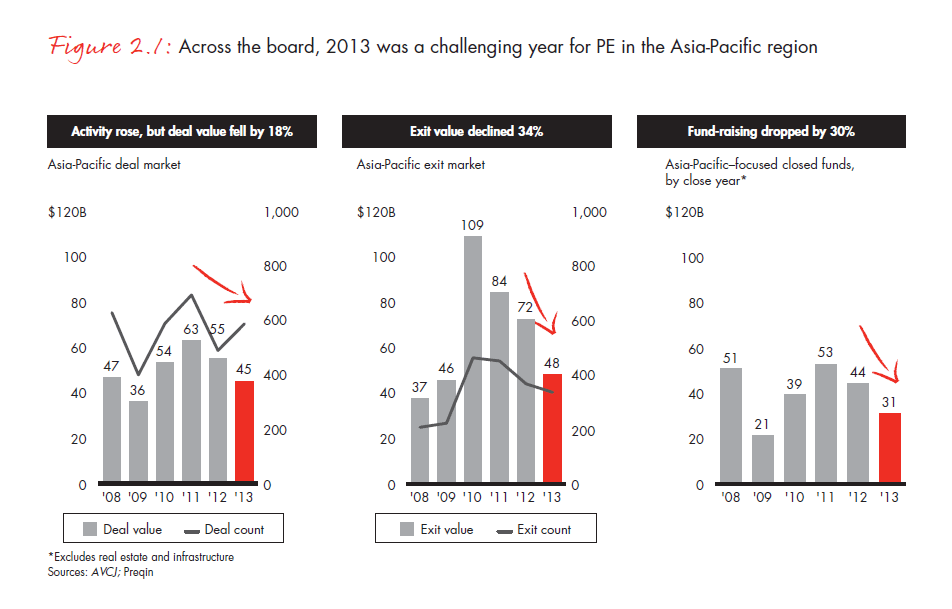
Investments: A shift to small-ticket deals
While the raw number of deals rose 20%, to around 600 transactions in 2013, total deal value dropped 18%, to $45 billion, leaving it almost 40% below the 2007 market peak. The numbers reflect a surge in small-ticket transactions involving early-stage Internet and technology companies but a sharp drop-off in the kind of mega-deals that move the value dial.
There was a scattering of $1 billion-plus transactions, including the Qatar Foundation Endowment’s roughly $1.2 billion acquisition of a 5% stake in Bharti Airtel, which boosted India’s value total. But the sovereign wealth funds and other government affiliates that typically lead the largest deals had their sights focused on the increasingly attractive developed markets (see Figure 2.2). Korea offered the region’s one true bright spot in terms of sustained deal flow: Volume grew for the third year running as LPs and global and regional GPs searched for viable in-region alternatives to former darlings China and India (see Figure 2.3).
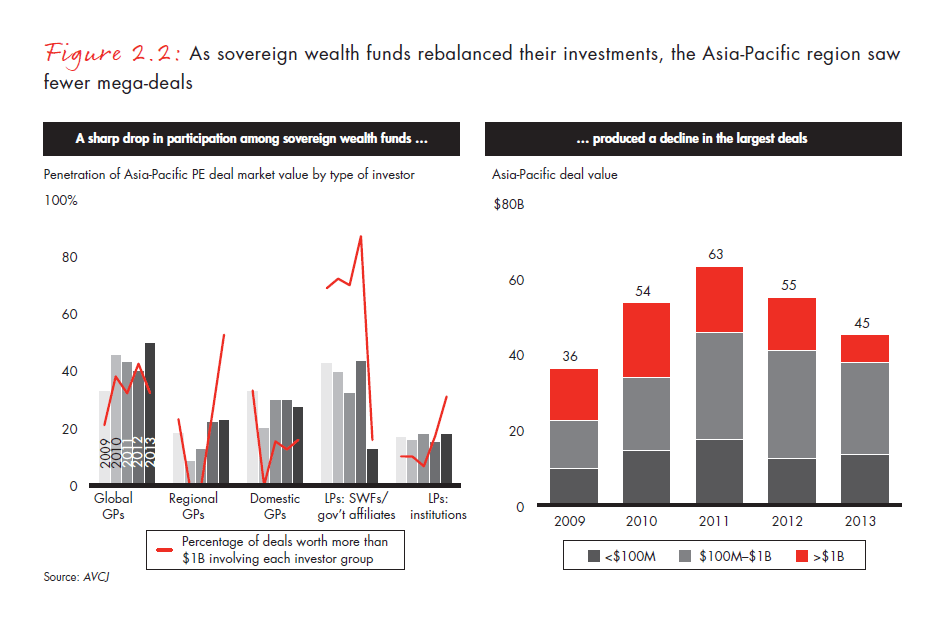
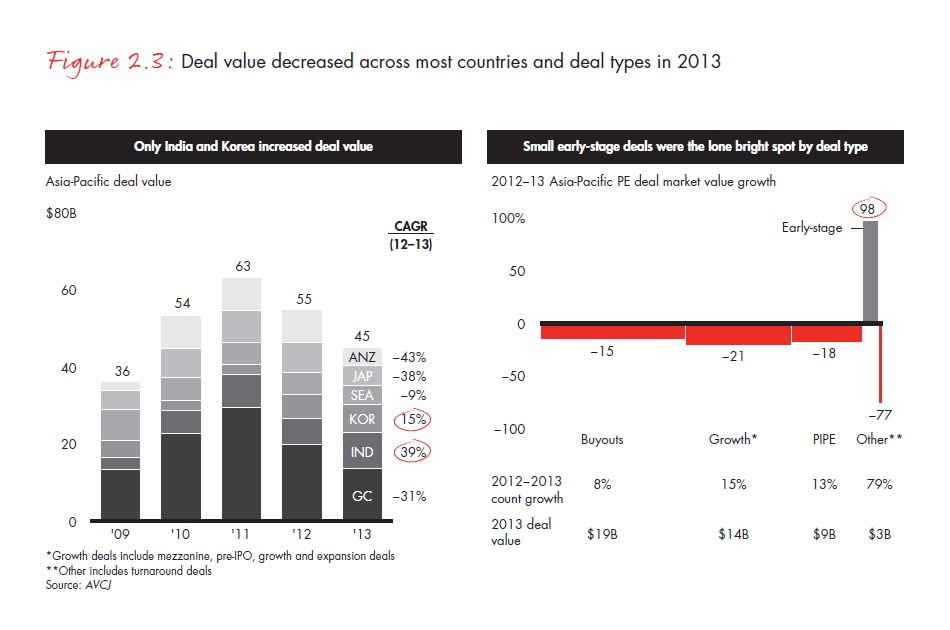
Deal value suffered from a troublesome combination of weakening economic conditions, stubbornly high asset prices and volatile public-offering markets, which discouraged pre-IPO deals. The region as a whole felt the ripple effects of slowing GDP growth in China, as the world’s second-largest economy wrestled with less vibrant consumption, uneven commodity prices and government efforts to rein in credit markets. In addition to inflation and currency woes, India suffered from declining industrial output and worries about the direction of government policy.
While macroeconomic weakness might normally be expected to put downward pressure on company multiples, heavy competition for a limited number of deals had the opposite effect (see Figure 2.4). With GPs sitting on a record $138 billion of unspent dry powder and potential corporate buyers flush with record amounts of cash, any attractive company drew a horde of suitors, emboldening sellers to demand higher prices. Wary of repeating past mistakes by paying too much amid an uncertain economic outlook, GPs that could afford to wait mostly held their fire.
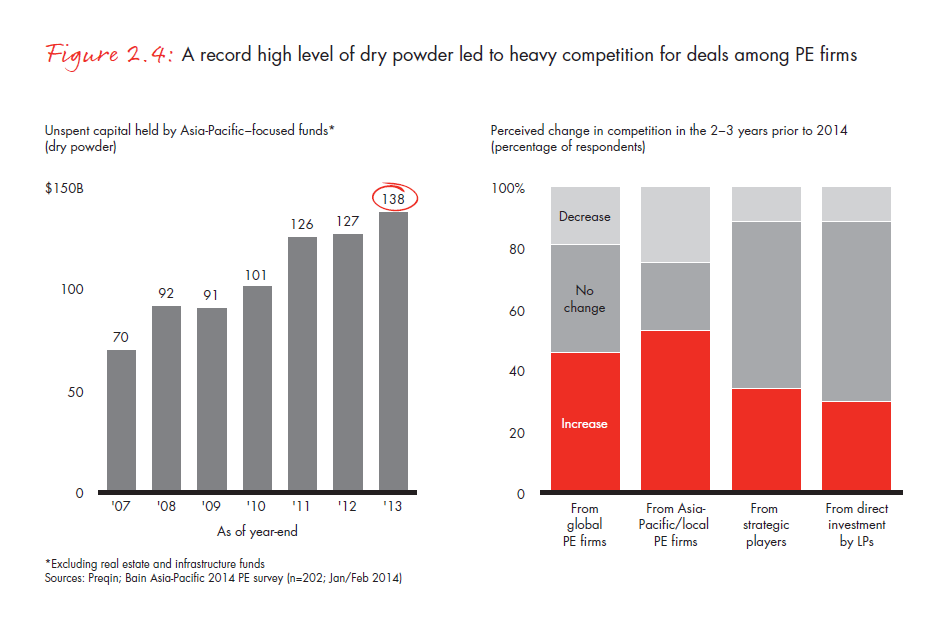
Exits: Trouble in the IPO channel
The resulting difficulty in finding affordable targets was matched by an inability to unload a record $215 billion in unrealized value. Exit activity dropped 34%, to $48 billion, marking the third consecutive year of decline. GPs were certainly eager to cash out aging investments so they could increase distributions to anxious investors. But economic uncertainty and extreme volatility in the IPO channel left them frustrated.
China’s market for A-share offerings (those quoted in renminbi) was shut down in 2013 as the government sought to root out fraud. And throughout emerging Asia, public markets were highly unstable—most notably in Indonesia, where equities shot up 20% in the first half of the year before collapsing in later months. The lack of a viable IPO channel not only crimped exits but also contributed to the drop in investment transaction volume (see Figure 2.5). Market volatility reduced opportunities for pre-IPO deals, especially in China, and persuaded some company owners to wait for a more opportune time to sell.
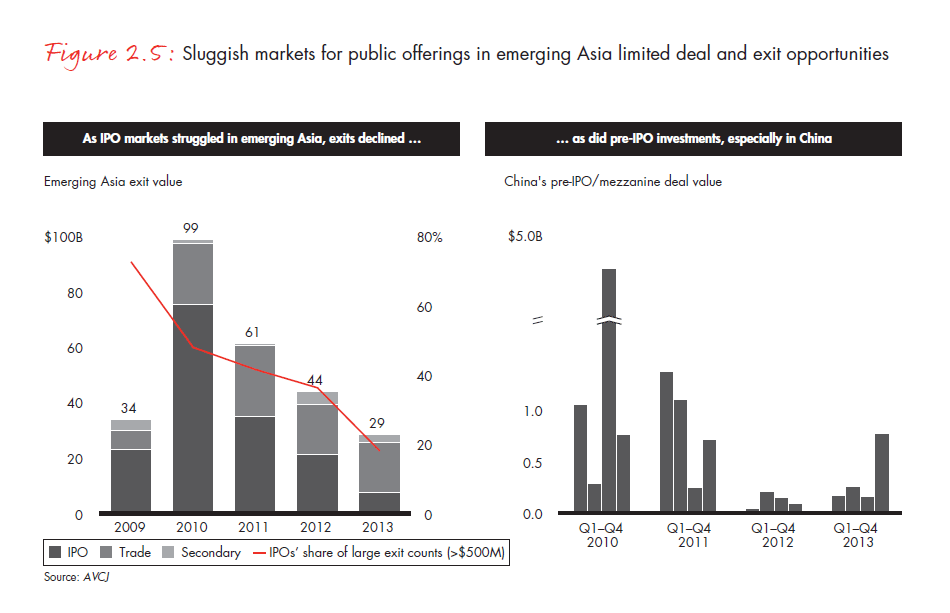
Fund-raising: A flight to quality
Against this unsettled backdrop, it is hardly surprising that fund-raising has continued to decline in the region, with allocations to Asia-Pacific–focused funds dropping 30% in 2013, to $31 billion. After pumping record amounts of capital into the region with too little to show for it, LPs have been rebalancing their portfolios and directing their commitments to other markets.
As investors slow their capital flows to the Asia-Pacific region, they are also becoming increasingly disciplined about which firms they will invest with. LPs have made a pronounced shift in allocations to the largest, most experienced GPs. Over time, as weaker firms fail to replenish capital and slowly wind down, this will cull the number of PE firms active in the market. Meanwhile, LPs are seeking to diversify their geographic exposure. Regional funds raised significantly more capital in 2013 than country-specific funds, with GPs focused on Greater China (China, Taiwan and Hong Kong) bearing the brunt of the shift. Fund-raising by Greater China–focused funds rose to record levels over the past decade but dropped 64% last year, as LPs became concerned that capital was piling up, leaving them overallocated in the market.
This clear flight to quality has begun to reshape the Asia-Pacific PE landscape. Up until 2011, raising a fund in the region was relatively easy. But most GPs seeking new capital in the market struggled during 2013, with about 60% of them failing to meet their targets. The average length of time it took to close a fund rose to 20 months.
Until GPs in the region can begin to whittle down their enormous backlog of unfunded commitments and produce more exits from boom-year vintages—especially in China and India—it is unlikely LPs will be willing to steer significant new commitments their way (see Figure 2.6). As we discuss in the final section of this report, competition for a reduced volume of investment capital will continue to favor the top echelon of PE firms—those that can truly differentiate themselves and demonstrate consistent performance.
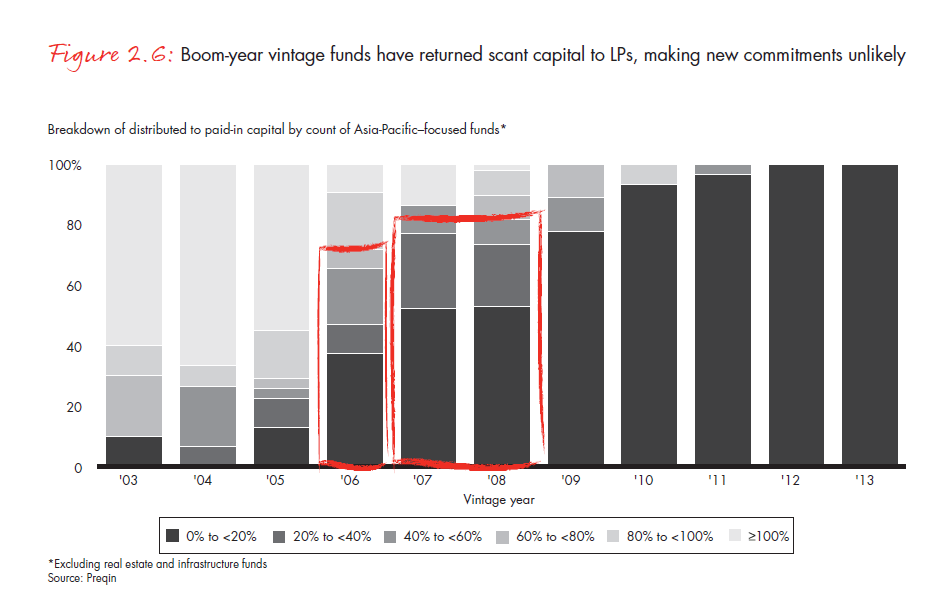
Returns: Not what the market expected
Amid the slowdown in deal making and exits, returns on investment have also disappointed. Simply put, GPs, on average, have failed to deliver on the high expectations that originally ignited the market. Though surveys show that more than 60% of LPs continue to expect returns of 16% or better from their Asia-Pacific investments, average returns have fallen short in recent years, especially for younger vintages. With distributions of capital falling well below contributions, LPs have been cash-negative in the region for nearly a decade (see Figure 2.7).
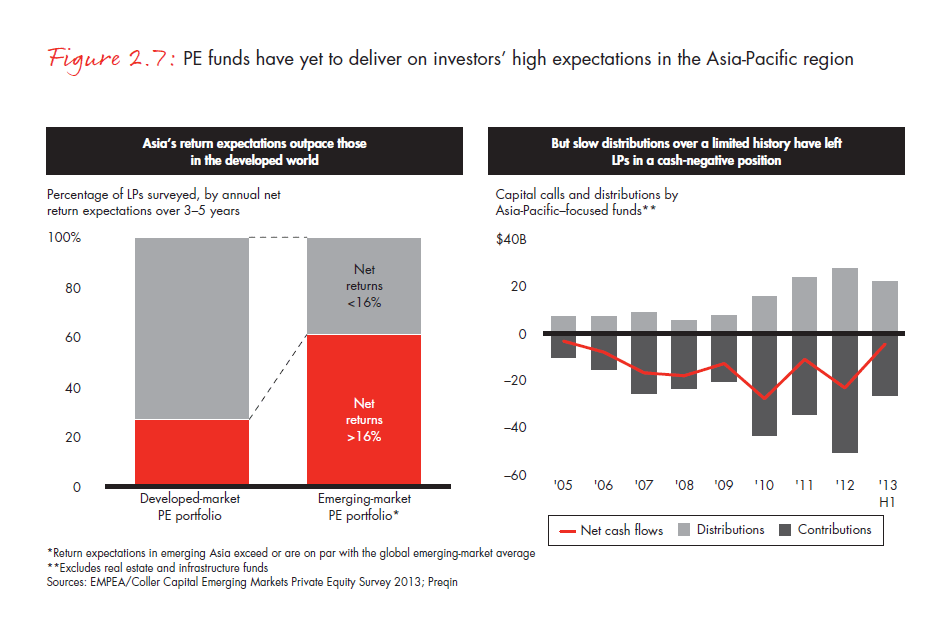
The lackluster performance has revealed a hard truth about the quality of investments made during the peak years: A large number of inexperienced funds bought at inflated prices and settled for taking minority stakes, which left them little room to maneuver when growth slowed in markets like China and India. As in any downturn, performance has varied widely among individual market players. The gap between top-quartile and bottom-quartile funds in the Asia-Pacific region has been wider than in North America or Europe, with a relatively large number of money-losing funds at the bottom dragging down average returns. But even among the best funds, few have topped the key threshold of 16%, fueling a nagging perception that the rewards of investing in the Asia-Pacific region are not making up for the risks—at least not yet.
3. Outlook: Is an inflection point near?
Given the stiff headwinds facing the Asia-Pacific region, working through the excesses of the pre-2011 period will likely take years—not months—as PE firms scrub their portfolios and the market weeds out the weakest players from a still-crowded field. As we’ve noted, the cleanup process is in motion—particularly in China and India, where a significant number of firms are slowly but surely winding down their funds. But the transition to a new cycle of healthy growth will take time, and the inflection point remains in the middle distance.
Still, 2014 is off to a promising start: With $22 billion in new deal activity, including large transactions announced in Korea, Singapore, Greater China and India, the market locked in almost half of 2013’s total investment value by the end of the first quarter. To get a clearer picture of what private equity firms on the ground are thinking and planning, Bain & Company surveyed more than 200 senior PE executives across the Asia-Pacific region. Their responses demonstrate that the industry has not lost its enthusiasm for the region’s long-term potential, despite the short-term impediments to market activity.
This durable optimism springs from the Asia-Pacific growth story, which remains exceptional by global standards. According to the Economist Intelligence Unit, a region that made up just 26% of global nominal GDP in 2000 is expected to command nearly 45% of world output by 2030, as an expanding middle class produces a sharp rise in consumption. The Asia-Pacific economies remain attractive diversification options for investors, and GPs have only begun to mine the opportunity presented by a large stock of private companies. Indeed, though PE activity has exploded in the region over the past decade, it is still in its infancy, trailing global averages as a percentage of regional GDP.
All this and the recent uptick in activity bode well as the region struggles to emerge from its current hangover. Moving forward into 2014, a number of factors may help build on this budding momentum.
Returns: Weeding out excesses
The downward pressure on current Asia-Pacific private equity returns owes partly to more difficult economic conditions. A variety of factors have caused growth to decelerate across the region, which has altered the trajectories of even the healthiest companies. But returns on invested capital are also suffering from the inflated expectations— and attendant lack of investment discipline—that characterized the market in the early half of the last decade. The wide gap between the returns of top-quartile and bottom-quartile firms suggests that a flood of capital to inexperienced GPs produced a large number of questionable deals that faltered when macroeconomic conditions worsened.
The effort to winnow out these bad assets will be a long slog for many funds, especially given the painfully slow pace of exits in the Asia-Pacific market and the mountain of unrealized value stuck in private equity portfolios. But several factors indicate the process is in its advanced stages, and the market will benefit in the future from a new level of investment discipline.
As we mentioned in our introduction, a close analysis of the exit overhang shows that only one-third of the buyout market’s total unrealized value represents deals closed before 2008, when company valuations were at their highest and restraint was at its lowest. That means approximately two-thirds of the companies waiting to exit were bought during more moderate times, and the majority of that total represents investments made since 2010. At the same time, fund-raising data shows that LPs’ flight to quality began in the aftermath of the global economic crisis, in 2009. Starting in 2010, capital flowing into the market began to favor the experienced funds with the best returns. By 2013, these winners accounted for almost 80% of capital raised in the Asia-Pacific region (see Figure 3.1).
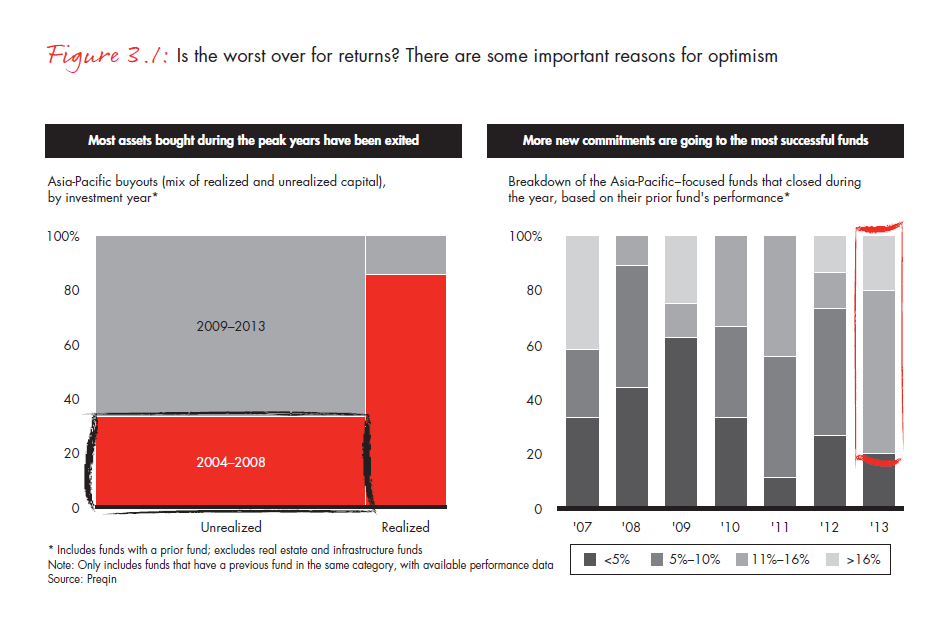
This analysis suggests that the worst of the post-boom correction may be over. Short-term returns will still come under pressure from the underperforming funds crowding the market. But the capital flows demonstrate clearly that a shakeout is in progress, promising to clear the field so the best performers can take full advantage of the region’s strong fundamentals. Based on Bain’s survey, GPs on the ground remain sanguine: Approximately two-thirds expect average returns to rise above 16% over the next three to five years (see Figure 3.2).
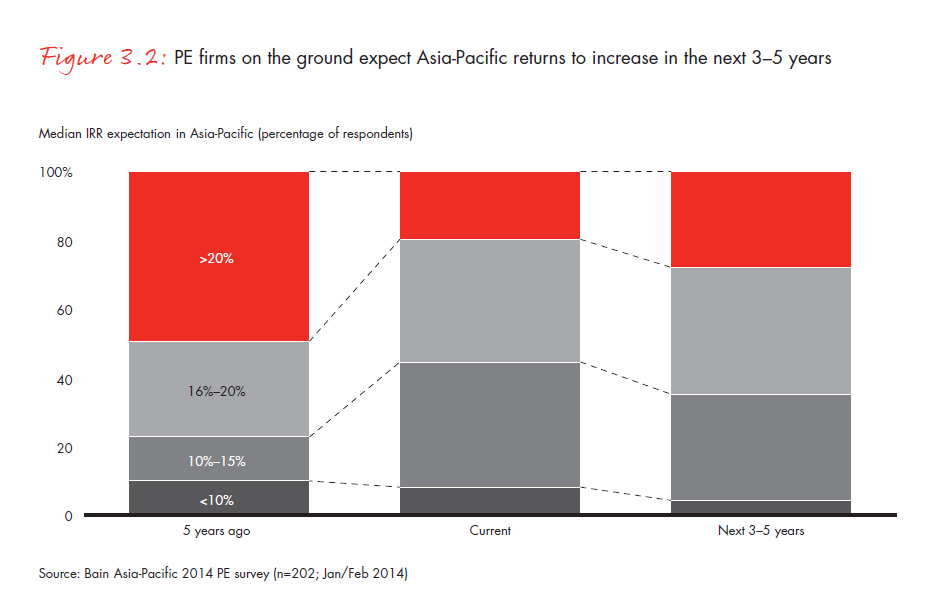
Investments: Heavy pressure to do deals
Guarded optimism also extends to deal making. Nearly 70% of industry participants in Bain’s survey predict deal activity will increase by at least 10% in 2014, driven by expected improvement in the macroeconomic outlook and an easing of valuation expectations among sellers (see Figure 3.3).
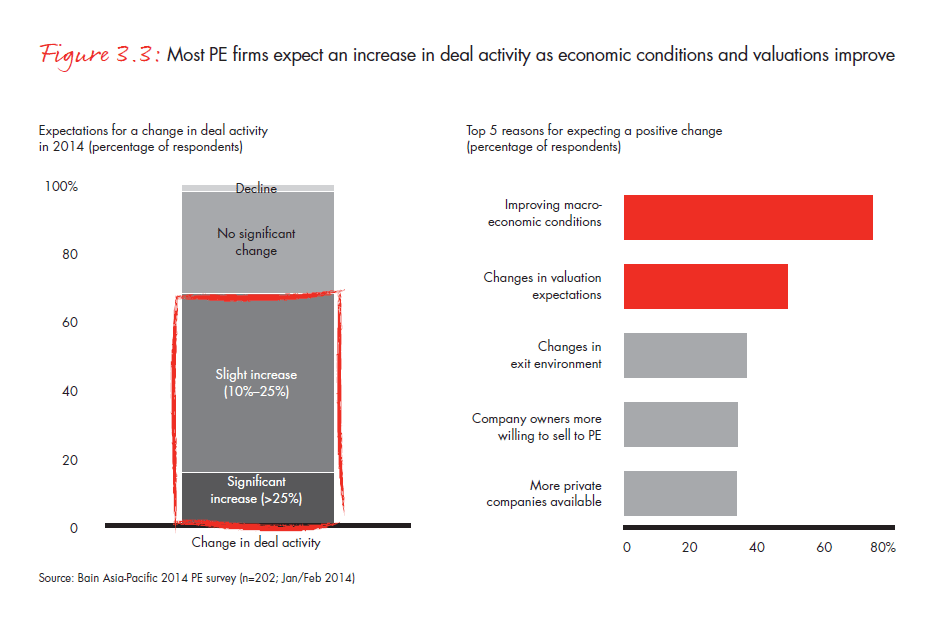
While countervailing arguments can be made around both those factors—especially valuations—there is no debate that the demand to do deals will be strong. GPs throughout the region have growing stockpiles of aging dry powder, and the pressure to put capital to work will undoubtedly keep them motivated. Asia-Pacific–focused funds alone have a record $138 billion in unspent capital, representing 2.4 years of future investment, and the totals at global funds active in the region push that number even higher (see Figure 3.4). Given the overhang, it is not surprising that 70% of survey respondents said closing on deals was a top priority in 2014.
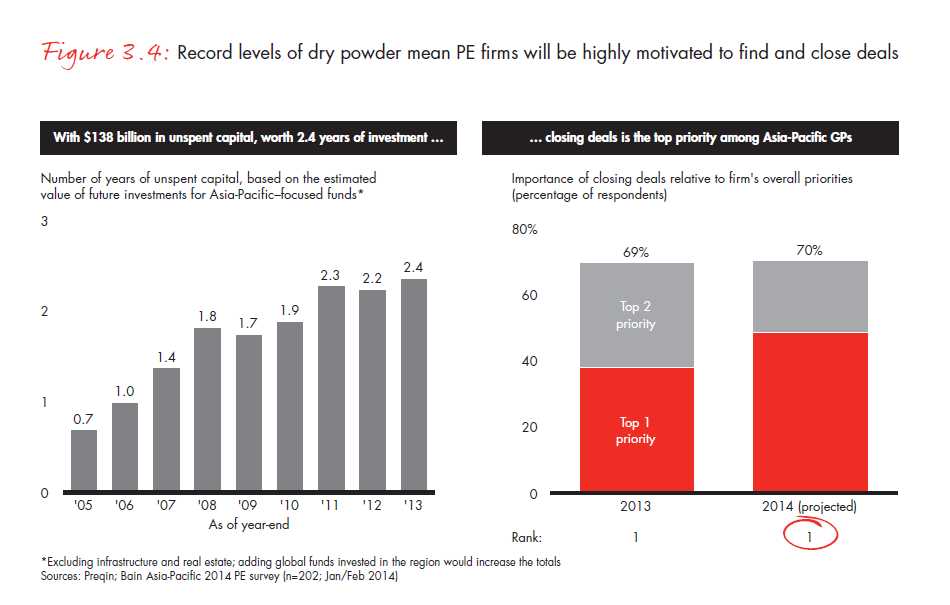
Several other factors may promote more deal making. Many of the region’s economies, especially China and India, will continue to grind through a number of painful adjustments. But as we discuss later in this section, conditions may improve sufficiently in some places to bring greater clarity to the outlook (see the sidebar, “Country perspectives: No ‘one size fits all’”).
On the ground, the market should also offer up a more continuous supply of deal opportunities. For many companies in the region, traditional sources of capital remain limited, and company owners have become more comfortable with private equity’s value proposition. Once reticent to give up anything but a small slice of equity, company owners are increasingly open to larger stakes and more willing to involve private equity professionals in decision making. This attitude shift makes opportunities more attractive to GPs and promises to give them more control over deal outcomes (see Figure 3.5).
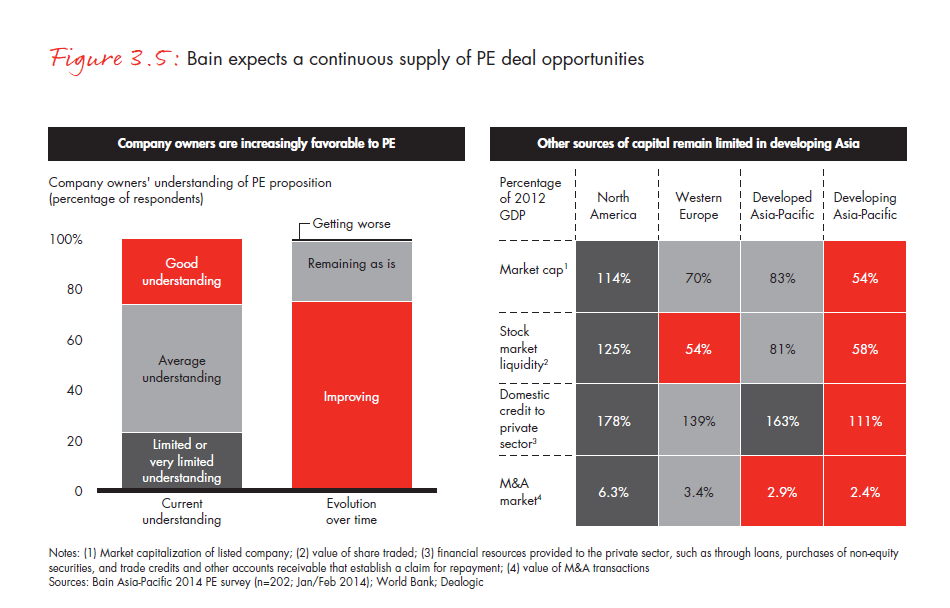
Whether there will be any short-term relief when it comes to valuations is an open question. The market shakeout already under way throughout the Asia-Pacific region should concentrate capital in fewer, more experienced hands, easing the rampant competition that has kept asset prices high in recent years. The crowd has already thinned somewhat in China, for instance, where a number of failing funds have stopped bidding on new deals as they concentrate on unwinding their dormant portfolios.
It is also likely that valuation expectations long buoyed by rising equity markets in emerging countries will ease somewhat as the markets’ underperformance in late 2013 sinks in. Market volatility has dampened the IPO channel, which takes away an important option for sellers.
As powerful as those forces might be, however, the market is still awash in a flood of ready capital from multiple sources, which is likely to maintain upward pressure on prices in 2014 and beyond. As GPs scour the region for places to put their dry powder to work, they will continue to bump into strategic corporate buyers with record amounts of cash. Though there may be more opportunities and fewer players, competition will remain fierce. In such an environment, GPs with the best local networks, industry knowledge and access to proprietary deals will have the advantage.
The investment outlook may also depend on how much progress China can make in its efforts to enact fiscal reforms as it works through its historic shift from export-led growth to an economy led by domestic consumption. China remains the region’s primary economic engine and affects growth from Indonesia to Australia.
Troubles on the mainland are the main reason investors continue to shift their allocations to other Asian countries. Bain’s survey respondents indicated that Southeast Asia has almost supplanted Greater China as the top destination for deals in the region. And looking ahead, GPs also expressed stronger interest in Korea and Japan. Regarding industry focus, they expect the most activity in the healthcare and the consumer sectors and will continue to favor buyouts, control deals and co-investments.
Exits: A combination of push and pull
The pressure to put money to work in the Asia-Pacific region is matched only by the pressure to extract value from the deals already made. After a three-year decline in exit activity, the average holding period for portfolio companies has extended steadily to 5.1 years (see Figure 3.6). The result is the region’s GPs are behind the curve in making distributions to investors—especially from recent vintages—dialing up the pressure to produce. Increasingly, LPs are making their discomfort known: Many are demanding exits before considering any further capital allocations.
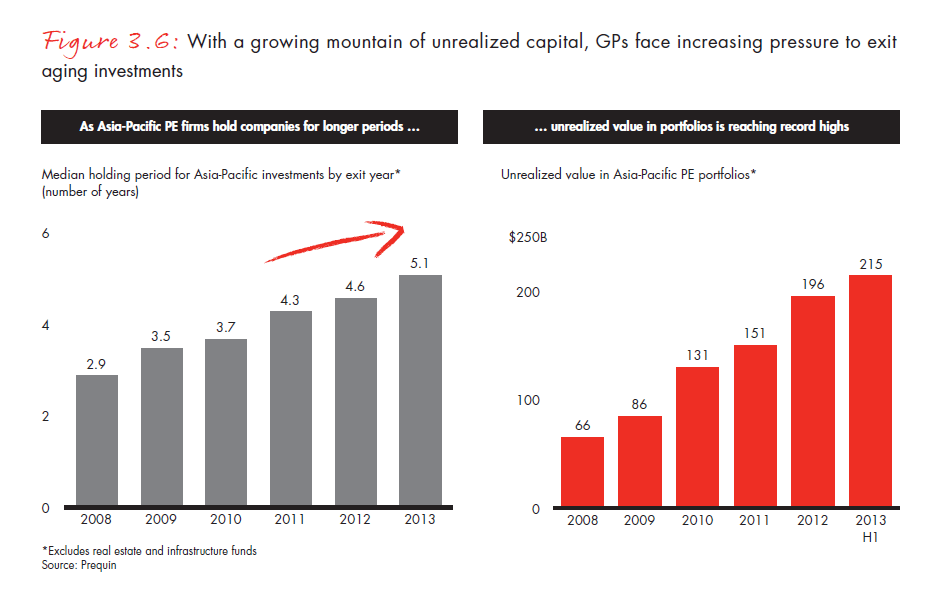
GPs acknowledge they need to push for more exit activity. In our survey, 70% said they expect volume to rise by at least 10% in 2014, partly because of the evolving pressure to return capital to LPs. But they are also hopeful there will be a higher level of pull from market demand. Favorable changes in the capital markets and a friendlier IPO environment, they believe, will create opportunities to sell at more attractive prices.
The same cash-rich corporate buyers that have been competing with GPs for deals are likely to be enthusiastic customers for portfolio companies. Strategic buyers increasingly see private equity ownership as a stamp of approval in otherwise unfamiliar markets, and many are eager to expand in the region. Sales of companies to other PE firms could also increase. With the exception of the Indian market, these “secondary” sales were soft in 2013 but should provide an attractive win-win alternative as GPs on both sides of the transaction look to buy and sell assets.
The health of the IPO channel is more difficult to gauge, but in many respects, it is hard to believe it could be any worse or more volatile than it was for emerging Asia in 2013. Stock markets in Indonesia and India have reacted positively so far to the coming elections, posting strong activity since the beginning of the year. Japan and Korea, meanwhile, could grow steadily this year, as interest from global investors builds. China, on the other hand, is a question mark. Activity there will partly depend on the state of the A-share IPO market, which the government closed for a second time early this year. The situation remains uncertain in other parts of the Asia- Pacific region, and overall activity may suffer from the prospect of tighter US monetary policy and the resulting strengthening of the US dollar.
Fund-raising: Waiting for action
Although their optimism and capital flows have clearly moderated, LPs in our survey still believe in the Asia-Pacific region’s long-term growth potential. Globally, their commitment to the PE asset class remains firm, and Asia is a crucial part of a diversified portfolio. In the short term, however, the industry’s dynamics will likely favor investment in developed markets, where recent distributions have been strong, requiring investors to add new capital to maintain proper allocation levels (see Figure 3.7).
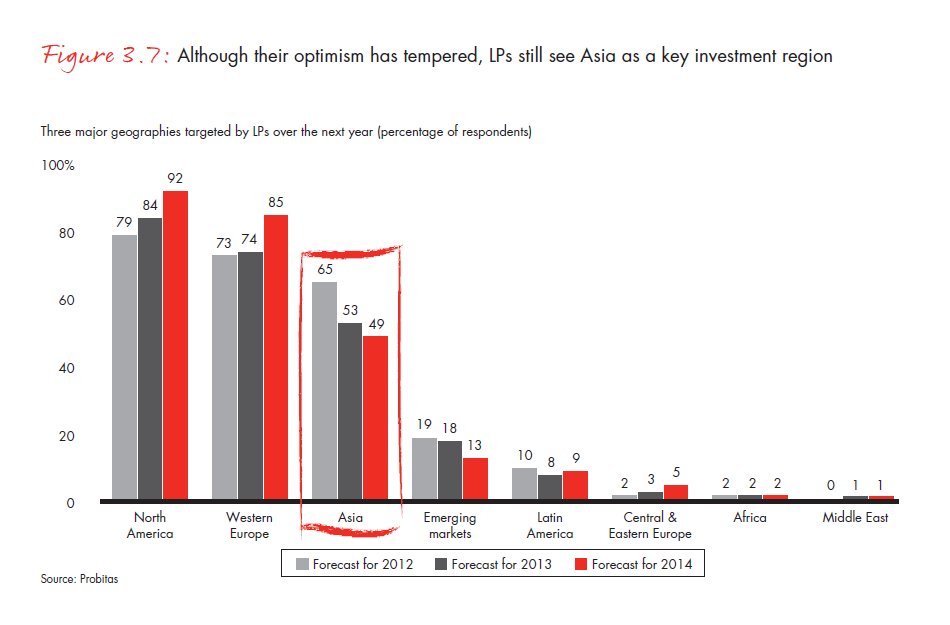
Historically, there is a tight correlation between PE market activity and fund-raising. Until exits and deal making rebound in Asia, LPs will be reluctant to increase their allocations to the region. As we’ve noted, LPs in Asia have been cash-flow negative for nearly a decade, meaning their contributions outweigh their distributions. A large exit overhang leaves LPs reluctant to commit new capital until they receive cash back from aging investments. Similarly, when GPs have trouble putting old money to work, LPs balk at new commitments, fearing they will become overallocated in a particular market or exposed to a liquidity squeeze if capital calls were to suddenly pick up.
So far in 2014, GPs have responded to investors’ reticence by trimming their demands. As many as 258 firms are on the road, seeking to raise new rounds of capital, but they have moderated their ambitions and are targeting smaller funds. Given that 65% of Bain survey respondents said they are planning to raise a new fund in the next 24 months, the number of funds on the hunt will increase throughout the year. But that is unlikely to produce a significant rebound in fund-raising in 2014 (see Figure 3.8).
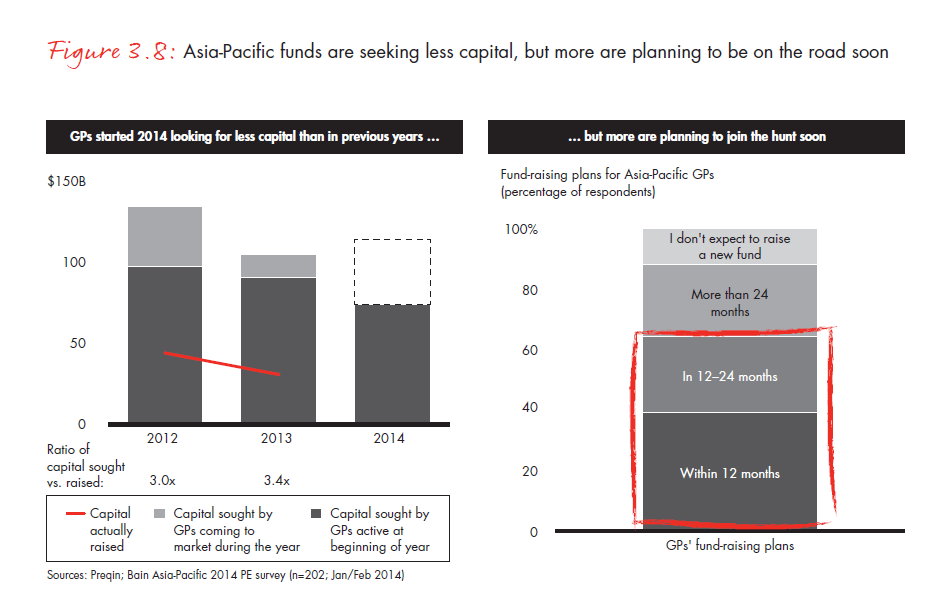
As we’ve noted, the data also indicates that the sharply reduced level of fund-raising in the region is flowing to an ever-smaller group of high-quality funds, a trend likely to intensify in 2014. LPs will continue to seek out the most experienced GPs and those with a demonstrated ability to generate strong returns. They will also gravitate to regional funds and global funds with Asia-Pacific exposure as they wait for country-specific bets to pay off.
With an oversupply of private equity firms seeking capital in the region and increased pressure from cash-rich corporates, competition for a smaller pie will only increase. That should accelerate the shakeout of weaker players as 2014 unfolds.
4. Going forward: What it will take to win
As we’ve observed throughout this report, the game has changed for PE firms trying to navigate a significantly more challenging Asia-Pacific region. The flood of capital surging into Asia over much of the past decade tended to lift all boats, encouraging GPs to pursue a single-minded growth strategy. But as LPs have softened their commitments, becoming increasingly discriminating about which firms they trust, winning has become less about accumulating the most assets and more about demonstrating a differentiated and repeatable model for success. Faced with this new reality, now is the time for private equity firms to reassess their strategies and sharpen their operational excellence.
Bain firmly believes that the structural imbalances impeding PE growth in the Asia-Pacific region will work themselves out with time, setting the stage for more healthy capital flows. It is unlikely, however, that LPs will become any less selective when it comes to picking the right GPs. Investors have learned valuable lessons through this downturn about what it takes to generate consistent returns in a set of markets as complex and diverse as those in the Asia-Pacific region. For private equity firms, performance and clarity of purpose have never been more important. Those that can’t state precisely what they stand for and how they will outperform the averages are likely to struggle against firms with a sharply differentiated strategy for consistently delivering value.
Where to play: Defining the firm’s sweet spot
In many ways, this change in the Asia-Pacific region mirrors a broader global shift in private equity. Growth and scale have long been the markers of success in the PE market. Size traditionally lures the best talent, wins the most deals and ultimately attracts the most capital. But in a post-financial crisis environment, growth alone is no longer good enough. The most successful firms are those that have rigorously defined where they should play and where they shouldn’t. They are preparing themselves to produce sustained growth by building high-performing organizations that can pursue these sweet spots relentlessly.
In the Asia-Pacific region, especially, focus matters. No two markets are alike; local connections are crucial; and even within a given subregion, levels of development and financial sophistication remain uneven. General excellence in pursuing private equity’s value proposition is clearly an essential asset. But as the increasing number of global firms building local Asia-Pacific operations can attest, differentiated knowledge, skills and market access often matter just as much.
The Asia-Pacific players attracting the most new capital are those capable of fleshing out where their skills reap the most rewards and sticking to this target investment area for the vast majority of their deals (see Figure 4.1). Are they focused on the right sectors, regions or types of deals? Where do they have the freshest proprietary insights and the strongest operating executives?
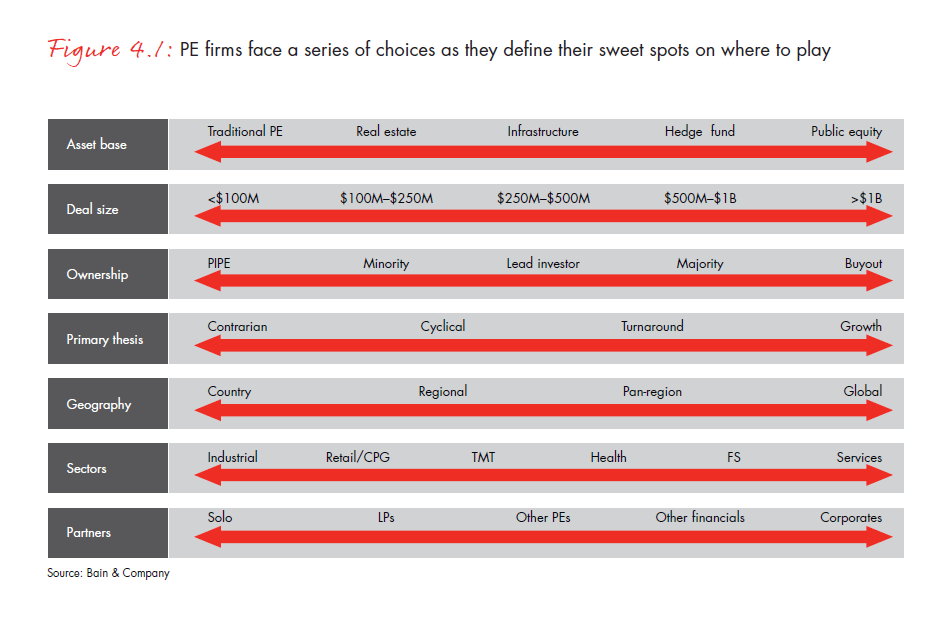
Casting a wide net remains important, since narrowing the firm’s focus too tightly can crimp the flow of new deal opportunities. What’s crucial, however, is to carefully calibrate the firm’s sweet spot based on a clear understanding of where it has derived the strongest returns to date and where it has strayed off course. Applying this sort of discipline to investment decisions can produce dramatically better results. Unique expertise across the firm’s talent pool produces the institutional confidence to choose the right battles and outbid less savvy rivals in auction situations. A clear definition of where to play also helps the firm’s investment committee identify which opportunities to reject and which adjacencies to attack opportunistically.
How to win: Building operational excellence
Defining where to play is essential. But creating an organization that can reliably outperform the averages within a given sweet spot is no less important. The most successful GPs know what makes them different and better than the competition. They deepen those unique capabilities into Repeatable Models® for sourcing deals, applying fresh insights, formulating exit plans and working with management teams to create better companies.
Creating operational excellence requires a close analysis of where strengths lie and which capabilities demand attention. How has the firm succeeded in the past, and what could it have done better? Many firms fine-tune these insights by using fact-based forensic deal analysis to probe a portfolio of deals after they’ve been exited, to discover which factors created the most value. This, combined with a 360-degree internal and external assessment, can help uncover what the firm is really good at. It will also surface opportunities for improvement across private equity’s value chain, from choice of sector to quality of due diligence and portfolio management. On the back of this rigorous approach, firms can develop the clearest roadmap for refining strategies and strengthening investment processes.
There are, of course, many paths to the winner’s circle. Strategic and operational considerations will vary significantly for different kinds of investors—from global and regional GPs to local investors and sovereign wealth funds. But in our experience, the most successful PE firms share a set of capabilities they can apply to all investments, even as they try to differentiate themselves in a crowded market. Five skills are paramount:
- First, top GPs build a deep proprietary network capable of surfacing the best opportunities and providing crucial market insights within their sweet spot. A strong network not only increases quality deal flow but also maximizes the chances of avoiding expensive auctions by gaining exclusive access to promising targets. Consider how Northstar Group, investing in Indonesia, and IMM or H&Q in South Korea use their local networks to secure exclusive deals in two of the Asia-Pacific region’s most competitive markets.
- Second, they base due diligence on a clear investment thesis. This allows GPs to develop an early understanding of where the value opportunities—and risks—lie. They are careful to vet potential targets to ensure they fall well within their predetermined sweet spot, tying this analysis to a firm understanding of what works and what doesn’t based on their assessment of past deals. When Bain Capital vetted potential investments in Domino’s Pizza and Skylark Co. in Japan, for instance, the firm drew confidence and insight from its experience with global restaurant investments.
- Third, the best firms develop a rigorous value-creation plan early, which will guide the management team as long as the fund owns the asset. Insisting on an owner-activist role, they also stay extensively involved post-acquisition, working with company management to focus on how to create value. KKR is a good example here: In building its Asia operation, the global firm has imported its proprietary portfolio management approach by creating a dedicated KKR Capstone team to focus exclusively on value creation, while working hand in hand with deal teams. Headland’s approach with Yonghui supermarkets also illustrates the activist approach. Instead of relying solely on board participation to guide value creation, the firm made sure the deal team was closely involved with planning and implementation.
- Fourth, they start thinking about their exit path from day one, continuously tracking options and identifying potential buyers early. The most successful GPs revisit their strategy well in advance of a potential divestiture, proving out hypotheses using rigorous fact-based analysis. They put themselves in the shoes of their target buyers, so they can understand and mitigate the most critical risks from the acquirer’s perspective. Then, in the year preceding the exit, they prepare the business to maximize multiples by optimizing profits and polishing the balance sheet.
- Fifth, they nurture a strong pool of operating managers that can help run the portfolio companies. Scarce professional and managerial talent in the Asia-Pacific region means top GPs must build their own network of professionals capable of understanding and executing the firm’s unique value proposition. Many leading firms turn to global expertise. EQT taps a wide network of seasoned industrial executives to serve in its portfolio companies. In Southeast Asia, for instance, the firm recruited a consumer products expert from Unilever to help manage a local food company. Other firms, such as Bain Capital, are also hiring human resources experts and deploying diagnostic tools to identify and address organizational needs within their portfolio companies.
These five skills highlight critical priorities, but they are by no means comprehensive. The best firms establish superior fund-raising capabilities and effectively manage relationships with investors. They nurture a strong, cohesive culture and develop a high-performance organization to support deal teams and develop new talent.
As the Asia-Pacific region works through its current transition, sharpening these essential capabilities will very likely determine who remains in the game. LPs are already making their choices. Winning their trust in a crowded market will require a clearly differentiated strategy for sourcing the best deals, creating the most value and delivering sustainable, above-market returns.
Country perspectives: No “one size fits all”
While the coming years promise both challenges and opportunities throughout the Asia-Pacific region, how things unfold will vary based on where one is looking. Differences in economic development, political stability and overall business environment have always made the Asia-Pacific investment landscape unique and complex. Spanning multiple nations—from highly developed economies such as Australia or Japan, which rely mostly on buyout activity, to large and buoyant emerging markets such as India or China, which are heavily skewed toward growth and minority deals—the region defies generalization. What’s certain is that the current transition will have an uneven impact on this diverse set of economies. LPs and GPs are hopeful for the coming year and beyond, but to varying degrees, depending on the market.
China: Cautiously optimistic
- Despite China’s first-quarter economic woes, PE deal momentum has actually improved since the second half of 2013, raising hopes among industry participants about future growth and returns. With two deals worth a total of $8.2 billion being finalized in the first quarter, 2014 is off to a strong start. The ongoing industry shakeout could help by lowering competition for some deals: In China more than anywhere else, LPs have become more discerning about where they place their bets.
- The wild card here is how China’s economic transition unfolds. Government efforts to rein in excesses in the lending and real estate sectors have unsettled investors by creating doubts about short-term growth. A prime example is the on-again-off-again A-share renminbi market, which the government has shut down twice. At the same time, the private equity industry could benefit from the uncertainty: A lack of other financing sources could make private equity’s deep well of capital an attractive alternative for companies looking to sell.
India: Recovery is under way, but a full transition will take time
- Unforgiving capital and debt markets favored PE deal activity in 2013, producing a few large deals, a surge of buyouts and overall growth of India’s private equity market. That has stirred confidence among GPs that the industry is working through its imbalances and will benefit from an improving economic outlook. The currency depreciation has been arrested, and the equity markets are on the upswing. The general elections are hard to predict, but the outcome may improve the regulatory climate. Private equity funds also recognize the “buy high, sell higher” days are over, signaling a welcome new level of discipline in the market. First-quarter activity has been buoyant, providing further positive signs that a recovery is under way.
- Given the long tail of unexited companies bought at peak prices before last year’s devaluation of the rupee, however, it will take time for the transition to develop in India . Even as macro indicators improve, PE funds see persistent challenges: a mismatch between buyers’ and sellers’ expectations, sluggish exit channels, ongoing regulatory issues and difficulty raising funds.
Southeast Asia: Brighter signs ahead
- As frustrated LPs have shifted their focus away from China and India over the past several years, markets like Indonesia, Singapore and Malaysia have been the natural beneficiaries. But in many ways, Southeast Asia has been a victim of its own success. Strong investment flows have dialed up competition for deals, putting upward pressure on valuations. Too many private equity funds have been chasing a limited pool of large, attractive companies. They have also encountered a rush of cash-rich corporates hunting for expansion opportunities, driving prices up further.
- Despite the short-term issues, Southeast Asia’s strong fundamentals make it one of the world’s most attractive developing markets. LPs continue to view many of these markets favorably. Though valuations and a limited deal pool may constrain activity to a degree, a record high level of dry powder and a large number of GPs on the ground will undoubtedly increase pressure to do deals. A Temasek-led agreement in principle to buy Singapore’s Olam International for around $2 billion gave 2014 a strong start.
Korea: Should remain an Asia-Pacific bright spot
- Having enjoyed two years of strong growth in deal value, Korea has bucked the region’s downward trend. But the increased attention from regional and global players has come at a price: As in Southeast Asia, private equity funds see strong competition and elevated price expectations as two potential barriers to deal activity. With upward pressure on entry prices and lingering holding periods, PE funds will find it increasingly difficult to create value from their holdings, especially given Korea’s limited pool of skilled portfolio managers.
- Even so, most GPs expect conditions to remain positive, especially as the government enacts plans to relax rules on M&A activity. Amid a scarcity of traditional financing sources such as corporate bonds and long-term bank loans, an increasing number of private companies are becoming available. Owners are warming to private equity’s value proposition, and PE funds have enjoyed a diversified deal flow, including distressed deals, cash-outs, noncore carve-outs and secondary offerings. This year’s first quarter started well, buttressed by the Carlyle Group’s planned $1.9 billion carve-out of Tyco’s ADT Korea unit.
Japan: Stable to improving conditions
- Several factors, including a tax hike, have clouded Japan’s near-term economic outlook, but GPs and LPs alike maintain interest in finding deals there. Although deal value in Japan declined in 2013, the number of deals increased, and GPs see fairly strong pipelines. The ready availability of low-cost debt should allow them to compete with the public markets, and a tentative increase in primary deals has bolstered the market’s cautious optimism. A stable flow of exits has also continued to return money to LPs, enabling them to re-up with funds focused on the market.
- Survey respondents, however, expressed concern that the increased levels of interest might make it difficult to find deals at attractive valuations. On the exit side, while LPs will likely see meaningful capital distributions in 2014, not all will come with high returns: A number of PE funds in the market that are nearing the end of their life spans will still have to exit their assets, including some that have underperformed.
Australia: Mixed perspectives
- An upswing in successful private equity IPOs and dividend recapitalizations last year cleared some of Australia’s exit backlog and returned significant capital to LPs. That will make it easier for GPs to raise new money—a key priority for 2014—though fund-raising will likely remain competitive. A favorable debt market and a downward trend in valuations have also created some assurance that deal activity will pick up.
- At the same time, Australia’s commodity-led growth has slowed. The equity market has been volatile in recent months, business conditions have deteriorated slightly, and consumer confidence fell to a 10-month low in March 2014. Against this backdrop, closing deals will continue to require significant effort on the part of private equity funds.
Addressed market definition
The Asia-Pacific private equity market as defined for this report:
Includes
- Investments and exits with announced values of more than US$10 million
- Investments and exits completed in Asia-Pacific: Greater China (China, Taiwan and Hong Kong), India, Japan, South Korea, Australia, New Zealand and Southeast Asia (Singapore, Indonesia, Malaysia, Thailand, Vietnam and the Philippines)
- Investments that have closed and those at the agreement-in-principle or definitive agreement stage
Excludes
- Bridge loans, franchise funding, seed/R&D financing, concept deals and deals involving distressed assets
- Any non-PE or non-VC deals (e.g., M&A, consolidation)
- Real estate, hotels and lodging, and infrastructure (e.g., airport, railroad, highway and street construction; heavy construction; ports and containers; and other transport infrastructure)


















